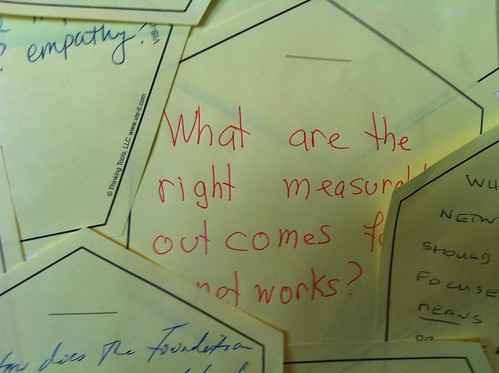
Note from Beth: Since the concept of working in Networks is can be hard to explain to newcomers, learning from case studies, stories, and examples can be illuminating. The design was to share this learning was amazing. In the morning, each of the ten case study presenters gave a 5 minute “teaser” about their case study or what one presenter called “showing a little leg.” After lunch, conference participants got to to choose two presenters to spend an hour with in a small group to ask questions and deepened the learning.
Guest post by Laura Efurd
Ho’owaiwai means wealth or “to enrich” in Hawaiian. It is the name of a network of public and private organizations, communities, families, individuals, financial institutions, government and funders organized to build wealth and financial stability of Hawaii’s working families. (http://assetshawaii.org/about/)
At the core of the network is the Hawaii Alliance for Community-based Economic Development who serves as a “network weaver” to connect, support and catalyze action among the network. It is supported by the Hawaii Community foundation and a coalition of 11 funders.
This afternoon we got a chance to explore specific examples of activating, supporting and leveraging networks. I gravitated to this session for slightly personal reasons — originally from Hawaii I always love to connect with what is going on back home – and I am glad I did! We had a great discussion led by Bob Ages of the Hawaii Alliance for Community-based Economic Development (http://www.hacbed.org/), and Chris van Bergeijk and Kina Mahi of the Hawaii Community Foundation (http://www.hawaiicommunityfoundation.org/). Learning from the Ho’owaiwai experience, here are my five takeaways on cultivating successful networks:
Culture and Values: When Bob or Chris talk about this network you immediately realize that it this is a network steeped in the culture and values Hawaii’s communities. The idea of Ho’owaiwai is not just about building wealth but is a notion of collective responsibility to create and sustain assets in a community. The network was built through “ohana” (family) dialogue where individuals have the opportunity to share their needs and potential solutions.
Look for Alignment: The issue of economic security was not new for the Hawaii Community Foundation. They had been funding a number of groups or initiatives in the areas of economic security and asset building. They saw an alignment between the goals of the Ho’owaiwai Network and what they area already involved in, but It was a new way to tackle issue.
Trust between network and funder: Key in the decision to support the network and the success of network has been the trust established between the Ho’owaiwai Network and the Hawaii Community Foundation. “It was a negotiated process”, said Chris van Bergeijk. The foundation had to trust Bob and the vision for the network.
Quality of the Weaver: Finding the right Network Weaver was key to the success of this Network. Bob described the key quality as being a “Jedi” (yes, as in StarWars). It is someone who can connect the dots and establish a framework so that all parts of the network can see themselves connected to something bigger. It is someone who has humility and realizes that this is about something bigger than themselves or their organization. My favorite quality of a Network Weaver shared by Bob is “ Can be child like enough to be in awe of what people bring.”
Change is Constant: The network is not static, it moves, evolves and changes. The most interesting point here was the discussion around the future of the network for the Hawaii Community Foundation. Supporting the Ho’owaiwai network through a network of 11 funders brings challenges and opportunities as they think about how to build the network of funders along side the Ho’owaiwai network. How to they grow the funds and the involvement?
Laura Efurd is Chief Innovation Officer at ZeroDivide – @zerodivideorg, @LEfurd
